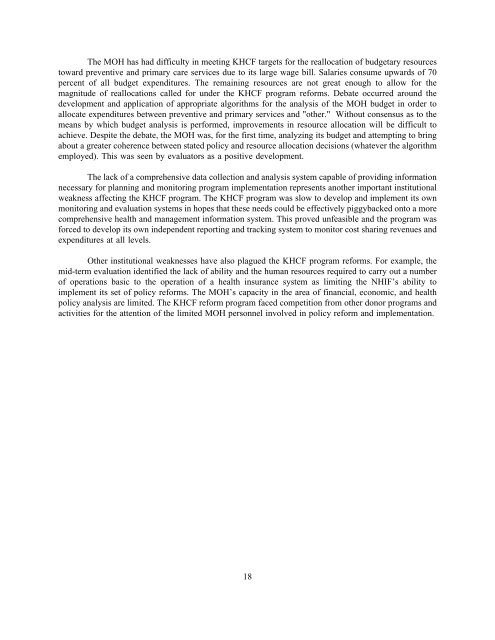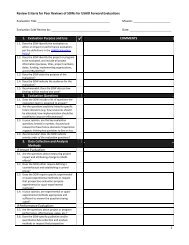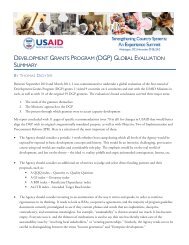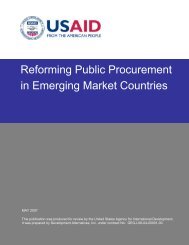Study on USAID Non-Project Assistance Programs in
Study on USAID Non-Project Assistance Programs in
Study on USAID Non-Project Assistance Programs in
Create successful ePaper yourself
Turn your PDF publications into a flip-book with our unique Google optimized e-Paper software.
The MOH has had difficulty <strong>in</strong> meet<strong>in</strong>g KHCF targets for the reallocati<strong>on</strong> of budgetary resourcestoward preventive and primary care services due to its large wage bill. Salaries c<strong>on</strong>sume upwards of 70percent of all budget expenditures. The rema<strong>in</strong><strong>in</strong>g resources are not great enough to allow for themagnitude of reallocati<strong>on</strong>s called for under the KHCF program reforms. Debate occurred around thedevelopment and applicati<strong>on</strong> of appropriate algorithms for the analysis of the MOH budget <strong>in</strong> order toallocate expenditures between preventive and primary services and "other." Without c<strong>on</strong>sensus as to themeans by which budget analysis is performed, improvements <strong>in</strong> resource allocati<strong>on</strong> will be difficult toachieve. Despite the debate, the MOH was, for the first time, analyz<strong>in</strong>g its budget and attempt<strong>in</strong>g to br<strong>in</strong>gabout a greater coherence between stated policy and resource allocati<strong>on</strong> decisi<strong>on</strong>s (whatever the algorithmemployed). This was seen by evaluators as a positive development.The lack of a comprehensive data collecti<strong>on</strong> and analysis system capable of provid<strong>in</strong>g <strong>in</strong>formati<strong>on</strong>necessary for plann<strong>in</strong>g and m<strong>on</strong>itor<strong>in</strong>g program implementati<strong>on</strong> represents another important <strong>in</strong>stituti<strong>on</strong>alweakness affect<strong>in</strong>g the KHCF program. The KHCF program was slow to develop and implement its ownm<strong>on</strong>itor<strong>in</strong>g and evaluati<strong>on</strong> systems <strong>in</strong> hopes that these needs could be effectively piggybacked <strong>on</strong>to a morecomprehensive health and management <strong>in</strong>formati<strong>on</strong> system. This proved unfeasible and the program wasforced to develop its own <strong>in</strong>dependent report<strong>in</strong>g and track<strong>in</strong>g system to m<strong>on</strong>itor cost shar<strong>in</strong>g revenues andexpenditures at all levels.Other <strong>in</strong>stituti<strong>on</strong>al weaknesses have also plagued the KHCF program reforms. For example, themid-term evaluati<strong>on</strong> identified the lack of ability and the human resources required to carry out a numberof operati<strong>on</strong>s basic to the operati<strong>on</strong> of a health <strong>in</strong>surance system as limit<strong>in</strong>g the NHIF’s ability toimplement its set of policy reforms. The MOH’s capacity <strong>in</strong> the area of f<strong>in</strong>ancial, ec<strong>on</strong>omic, and healthpolicy analysis are limited. The KHCF reform program faced competiti<strong>on</strong> from other d<strong>on</strong>or programs andactivities for the attenti<strong>on</strong> of the limited MOH pers<strong>on</strong>nel <strong>in</strong>volved <strong>in</strong> policy reform and implementati<strong>on</strong>.18







